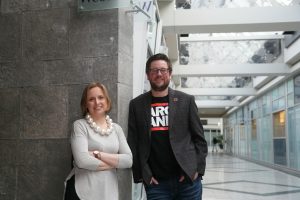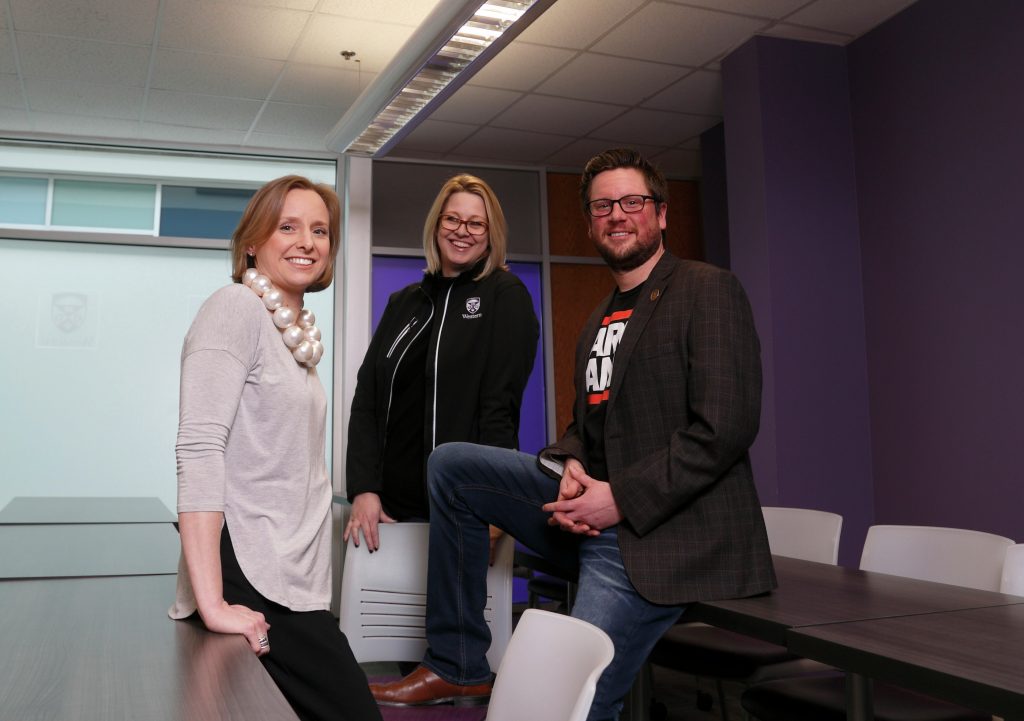Learning Credentials
Designed to complement an undergraduate degree, post-degree diploma programs are providing market opportunities for students and instructors alike
Photo (from left): Liisa Sheldrick, Jo Ann Johnston and Cole Mason
COLE MASON KNOWS first-hand the advantages of people applying practical experience to the skills they learned in the classroom.
Mason, vice-president market innovation at London digital media company Arcane, has watched for the past four years as students from the Western Continuing Studies Post-Degree Diploma Program have come through the door, applying that practical experience in internships that have directly benefited the company.
Last fall, his appreciation for what the students consistently achieve led him to try his hand at teaching.
“Since I joined Arcane almost five years ago, I’ve really been searching for my purpose in life. I’ve really narrowed it down to gaining knowledge and then sharing that knowledge with others,” Mason says. “At Arcane, we recently went through a leadership development program where we had to write our purpose down. For me, I had, ‘Learn it, live it, share it.’ Teaching at continuing studies was a natural progression of that.”
Western Continuing Studies started offering diplomas in the late 1990s in a variety of subjects. Currently, the program offers eight diplomas and most recently added marketing (2012) and human resources (2016).
The biggest growth has been in clinical trials management, occupational health and safety and human resources.
Jo Ann Johnston is the program’s community relations specialist, but she’s also been an instructor herself, teaching in the public relations stream for eight years. Through both roles she’s witnessed up close the evolution of the post-degree program, including just who is enrolling.
“I got to a stage in my career where I wanted to be able to contribute in the same way other people helped me along the way. And the students are often just as knowledgeable as those who are working in the field themselves” —Liisa Sheldrick
In 2017, for example, there were 2,700 students enrolled in 277 courses at Western Continuing Studies.
Johnston says many students today are enrolling with degrees in hand. They’re completing a post-secondary degree in multiple disciplines and then they’re asking themselves the question, “Now what?”
As a result, they look at the post-degree program and say they have to develop their skills in a specific way.
“Not only are they being taught by professionals in the field, but part of their education is where they have these practicums where they are applying what they are learning out in the real world,” Johnston explains. “It starts to bridge the gap between their education and actually getting a job. I think it’s applying what you’re learning.”
Liisa Sheldrick is another of the professionals lending their talents to the post-degree program.
Currently the corporate social responsibility and communications leader at 3M Canada, Sheldrick has been in the public relations fields since 2002.
She got involved with continuing studies because the program not only featured “an incredible group of professionals,” but it also fed into her own sense of professional responsibility.
“I’ve been taught, I’ve been mentored, by a lot of really talented people,” she says. “I got to a stage in my career where I wanted to be able to contribute in the same way other people helped me along the way. And the students are often just as knowledgeable as those who are working in the field themselves.”

In Mason’s Digital Marketing Strategies and Tactics class—as is the case with both Johnston and Sheldrick—he routinely brings issues into the classroom that came up at work earlier in the day.
There are “a lot of truths” that come out during conversations, Mason explains, adding the exciting thing is seeing how the students respond to those situations.
“The program develops the skills in a way we are able to pull the passion out of the students,” he says. “The smaller class sizes, the group work we’re able to facilitate, is something we couldn’t do in a classroom with hundreds of students. It’s pretty unique to have those one-on-one relationships, help guide people through their own internship application process and really guide them towards what employers are looking for.” ![]() Sean Meyer
Sean Meyer

